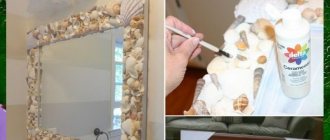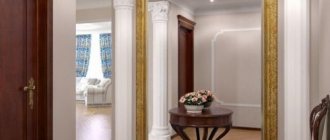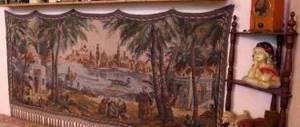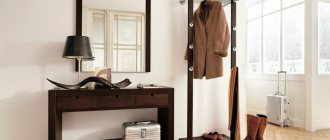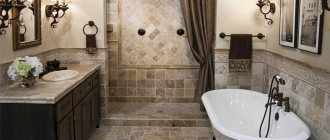Features of a mirror in the house
A mirror is an interior item used to reflect objects, animals, people, decorating rooms. From time immemorial, the accessory has attracted the fairer sex. The morning of many girls and women begins with an approach to him. The item was also used for magical rituals, and therefore it can be considered multifunctional.
The process of mirror restoration is very painstaking.
Interesting! There are many reasons why mirrors are not used in modern homes: decoration, division of zones, interior decoration, etc.
Depending on the lighting used, general style, personal preferences, you can buy either a simple accessory or one with effects on the surface.
To restore the surface of a mirror that has minor damage, grinding and polishing are used.
Tinted mirrors are especially popular. They find their application not only in minimalist styles, but also in luxurious art deco.
How to restore a mirror yourself
Any piece of furniture will sooner or later lose its original appearance. Of course, if a mirror breaks, there is only one way out - to recycle it. But minor defects can be restored. Mirror restoration is a complex, painstaking process.
Restoring a mirror at home is not a labor-intensive task and does not require much expense or time.
Experienced specialists in this field are able to put many fragments together and restore the original integrity. Scratches, dust, minor chips - all this is eliminated independently. Moreover, there is no need to purchase expensive tools.
Small damages are easier to repair at home using improvised means.
Important! Using high-quality and correct substances will return your accessories to their former attractiveness and shine. The main condition is to correctly calculate the dosage.
Preparation for the procedure
Finding a specialist who can restore amalgam is difficult. This process is not only lengthy, but also expensive. So why shell out such a sum of money and waste time if you can solve the problem yourself.
Sometimes restoring a mirror costs more than buying a new mirror.
Before you begin restoring a damaged mirror with your own hands, you need to perform several steps. To restore a large accessory inserted into the frame, it must be released from it. If this is not possible, the structure is placed on a flat, hard surface.
Before restoration, the mirror must be prepared.
Before minor repairs, it is enough to wipe off the dust and wash off the dirt. If possible, the attribute is left on the wall, thus simplifying repairs.
Materials and tools
After watching videos or photographs showing how to restore a mirror, it becomes clear how simple it is. Everyone has a set to carry out their plans at hand:
- scissors and napkins;
- degreaser;
- foam sponge;
- tassels;
- transparent glue;
- hard brush;
- glass cleaner.
To replace amalgam, many people use foil, which is thin but durable. Glue with a composition intended for working with glass. Its structure should be transparent, both before application and after hardening.
How the mirror was invented
A mirror is a very simple object, but many mystical traditions and legends are associated with it, attributing almost paranormal abilities to them. We will tell you about the main stages in the development of mirror production and the most interesting stories associated with them in this post.
The first mirror can be considered the smooth surface of the water where our ancestors looked. Most likely, they did not immediately realize that it was them in the reflection, but gradually they realized it. The myth of Narcissus, who died falling in love with his own reflection, is associated with admiring oneself in the reflection of water.
Narcissus
In Turkey, archaeologists found polished pieces of volcanic glass - obsidian. Its age reaches about 7.5 thousand years. Mirrors were also made from stone, rock crystal, bronze, silver and gold. Only extremely wealthy people could afford such a mirror, since the mirror had to be carefully looked after. Bronze mirrors were made by pouring bronze into special molds. After the alloy hardened, it was carefully polished until it began to reflect sunlight.
Modern obsidian mirror
Ancient metal mirrors were known in all cultures before our era. They were made round like the sun, and they were credited with not only otherworldly, but also cleansing properties. For example, wars took mirrors with them to reflect their death. From antiquity to the present day, many legends have survived. One of them is dedicated to Perseus, who managed to outwit the Gorgon Medusa with the help of a bronze shield, forcing her to look into her shield like a mirror, which led to her petrification.
Bronze mirror. Back side. It is clear that over time an oxide film forms on bronze and it turns green.
Bronze mirror
Destroying ships using a mirror. Archimedes rejoices.
The brilliant inventor of antiquity, Archimedes, managed to use a mirror as a weapon. During the Punic War, Archimedes used mirrors to burn the Roman fleet that was besieging Syracuse. This day is 212 BC. e. the surviving Romans remembered it for the rest of their lives. Hundreds of small suns lit up on the fortress wall. At first they simply blinded the crew, but soon the incredible happened - the leading ships of the Romans began to flare up one after another, as if they were burning torches. The enemy's flight was panicky. Of course, there are significant disagreements regarding this historical fact. Thus, some scientists believe that Archimedes did not burn ships with the help of mirrors, but only used them as a guidance system for some kind of arson machines (prototypes of Greek fire could have been known to Archimedes even then).
The first glass mirrors were created by the Romans in the 1st century. n. e. The glass plate was connected to a lead or tin spacer, so the image was more vibrant than on metal. But since the process of the appearance of this kind of mirrors coincided with the collapse of the Roman Empire and the rapid spread of Christianity, mirrors began to go out of use (in Christianity the human body was considered dirty and sinful). In Christianity, a real war was declared on the mirror, since it was considered the product of the devil. It is interesting that in Eastern culture the attitude towards the mirror is exactly the opposite. In China, mirrors were made that were considered magical.
Ancient roman mirror
The modern history of mirrors is usually dated back to the 13th century, when glassblowers appeared in Europe. They poured molten tin into a glass flask and then broke it into pieces, so the mirrors turned out to be concave and distorted everything. However, it was precisely such mirrors that became assistants to medieval magicians and seers. They believed that concave mirrors are capable of collecting at their focus a certain astral light, which awakens the ability of clairvoyance in a person. In an incomprehensible way, looking ahead, back in the 13th century, Roger Bacon predicted the creation of a microscope and telescope, a car and an airplane. 200 years before the invention of gunpowder, he described its composition and principle of action. They say that the learned monk saw an amazing revelation in some mysterious mirror. Bacon himself mentioned it. Mirrors are also mentioned in the accusation that the churchmen brought against the greatest scientist of the Middle Ages:
He made two mirrors at Oxford University. With the help of one of them, he could light a candle at any time of the day. In the other, you could see what people were doing anywhere on Earth. Therefore, with the general consent of the university, both mirrors were broken.
It was only at the beginning of the 16th century that the Andrea Domenico brothers figured out how to make flat mirrors using mercury amalgam. The result was a sheet of mirror cloth, which was distinguished by its shine, crystal transparency and purity. But this secret was so carefully guarded in Venice that all the masters were moved to the island of Murana, where they became honorary prisoners. For a century and a half, Venice grew rich from the mirror monopoly, and the rest of Europe was almost bursting with envy.
Venetian mirror
The price of one Venetian mirror at that time was equal to the price of a small ship. Giving a mirror as a gift was considered the height of generosity. Only wealthy aristocrats and royalty could buy and collect them. For example, King Louis XIV was a passionate fan of mirrors. So, at one of the balls, Louis’s wife Anna of Austria came to the ball in a dress that was decorated with pieces of mirrors, which caused a wonderful glow in the light of candles at the ball. The dress cost the French treasury a lot of money, so it came to the point that his minister, Jean Baptiste Calbert, seduced the craftsmen from Muran with gold and promises and secretly took them to France. True, the Venetian authorities could not come to terms with such an insult and sent several threats to the masters so that they would return, but the masters ignored these threats, thinking that the king would be able to protect them. The Italian craftsmen enjoyed life, received high salaries and were happy with everything, until the most experienced of them died of poisoning, then a couple of weeks later the second one also died. Those who were still breathing realized that they would soon all be slaughtered like cattle, so they began to ask to go home. The French no longer kept them, because they had long ago mastered all the secrets of the masters. Thus, mirror technology became known throughout Europe, and Louis XIV built a mirror gallery for himself at Versailles. The French managed to surpass their teachers from Italy and improved mirror technology. Now mirror glass was produced by casting. The glass was melted, then the molten glass was poured directly from the melting crucible onto a flat surface and passed over it with a special roller. It is believed that the author of this technology is Luca De Negu. King Louis XIX rejoiced like a child as his guests were stunned by the brilliance of 306 mirrors.
Mirror Gallery at Versailles
Since that time, the mirror has taken its place of honor in the interior, and the manufacture of mirrors has become an important branch of European crafts. Not only the nobility and nobles wanted to have mirrors in their homes, but also artisans and merchants did not skimp on luxurious decoration for their homes and beloved women. Picturesque paintings of those times confirm the ongoing fashion for this item. Although the quality of the canvas remained low, its framing always met the latest architectural innovations. The frame has always become a real work of art. They could only compete with jewelry. They were cut from the most expensive types of wood and often decorated with precious stones. Frames and handles for small hand mirrors were made of silver, gold, bone and mother-of-pearl. Such a mirror was considered an exquisite and expensive gift, worthy not only of the beloved, but also of the empress herself. The rich people of the Baroque, Rococo and Classical times used mirrors immoderately, using them to decorate bedrooms, fireplaces and, of course, ladies' boudoirs.
In Rus', mirrors appeared much later than in Europe, and almost immediately the church declared them a demonic thing and an overseas sin, and therefore pious people avoided them. The taboo on mirrors was lifted only at the end of the 17th century, but even then not to the full extent. This is probably why there are so many superstitions associated with mirrors in Russian culture. In the old days in Rus' they used to tell fortunes using mirrors, and this was the most terrible fortune telling. The girl always locked herself in the bathhouse alone and placed two mirrors opposite each other. It was believed that at this moment a magical corridor opens in which you can see the future.
The first mirror production in Russia appeared, of course, under Peter I. The mirror factory was built in Moscow. In Peter's Russia, a mirror became a family heirloom. As a very expensive item, it was often given to a young girl as a dowry.
In the 18th century, mostly small mirrors were made, but in the 19th century everything changed - large format mirrors came into homes. This can partly be associated with the superstition of the townspeople, because it was considered a bad omen if a person in the mirror was not completely visible. For an ideal display from head to toe, mirrors were hung at an angle. Hence the massive base of the frame. It and the so-called kokoshnik were decorated with various designs and carvings, and for very rich customers even with precious stones. It is worth noting that Russian craftsmen have learned to make such huge mirrors. which amazed all of Europe. It is also interesting that Russian-made Venetian mirrors began to decorate even not very rich houses.
A revolution in the production of mirrors occurred in 1835 thanks to the German chemist Justus von Liebig, who began to use silver. This technology for making mirrors is still used today. In this short video you can take a look at the mirror production plant:
Mirrors have also found their use in the field of humor. It is possible that many of you reading this have been in a room of distorting mirrors, where your image is comically distorted in various ways.
Laughter room
Mirrors also have many scientific and industrial applications. The microscope and telescope have already been mentioned; with the help of mirrors, sunlight is concentrated in solar heating stations; they are used as reflectors in telescopes, searchlights, headlights, and heaters. Since the reflection in a convex mirror will always be virtual, it can be used as side mirrors in cars. The reflection will always be independent of the observer, which is why the driver does not see himself in the reflection of the mirror, but everything that he finds around the corresponding side of the car.
In medicine, otolaryngologists and dentists use concave mirrors to look into the most difficult to reach parts of our body. The ophthalmologist uses an ophthalmoscope, a spherical mirror with a small hole in the center, so that a beam of light from a lamp located on the side can be directed into the eye being examined. The light beam will pass from the retina and partially be reflected back from it, so the doctor will be able to see an image of the patient’s fundus.
One of the latest discoveries in science - gravitational waves, was made using a special system of mirrors. Here, two independently suspended mirrors oscillate in space due to gravitational waves, so the distance between them will be either smaller or larger.
The principle of interferometric detection of gravitational waves.
Step-by-step instruction
Before you think about how to restore a defective mirror at home, you need to look at the procedure. If you skip one of the stages, you will not be able to achieve the result.
Removing chips and scratches
Methods can be different; at home, those that do without specialized tools are preferable.
Given the desire and time, any home craftsman can carry out the restoration himself.
The simplest options:
- Toothpaste. Squeeze out a few peas and rub in with a flannel cloth using rotational movements. Once the paste has dried, the surface is carefully polished. Previously existing defects will no longer be noticeable.
- Nail polish. It is recommended to fill deep chips or scratches with a substance and polish them. Due to the fact that transparent varnish has a special consistency, it is used to repair mirrors. The substance is applied to the damaged area with a brush, the excess is removed, and all you have to do is wait for it to dry. Gently wipe the surface with a soft cloth; a slight shine should appear.
As you can see, it is not difficult to restore minor defects at home.
Cleaning Tarnished Surfaces
High humidity, bright rays of the sun - sooner or later this causes mirrors to fade or stains to form on them. To make the accessory shine again as before, you can use water, chalk and vinegar essence.
The method for preparing the solution is simple: add a spoonful of essence and the same amount of chalk to a glass of water. Immediately before use, the mass is heated and infused for several minutes. Place a few drops into a fluffy cloth and wipe the surface of the mirror with them.
Gently wipe the surface of the mirror.
Important! The method is relevant for attributes with an aluminum reflective layer.
Very dark stains can be removed with a mixture of water, magnesia (ammonia) and gasoline.
Amalgam restoration
A defect that appears on the back of the product is visually eliminated using foil. The mirror is removed from the frame or other structure and placed on a soft and flat surface so that the front side faces down.
Foil will help restore the mirror.
The required piece of foil is cut, smoothed, and glued to the defect site. A few minutes until it dries completely and there is no damage.
Frame replacement
No matter how beautiful the restored mirror becomes, little will change against the background of the old frame. Therefore, when repairing an accessory, do not forget about its “shell”. Some paint wooden frames, making them visually more attractive, while others prefer to replace them completely.
Be creative when choosing a frame for your mirror.
After watching a video on the Internet, it becomes clear that you can make a frame yourself, or you can purchase a ready-made one. There is nothing difficult about replacing it. The mirror is removed from the wall, the existing bolts are carefully unscrewed, and the accessory is removed.
You can find many designs of mirror frames on the internet.
In exactly the same way, it is inserted into a new frame, fixed with bolts or other devices.
Interesting! It is not recommended to insert a mirror that is too large into a new frame yourself; it is better to call a family member for help.
Decorating a mirror
A wooden frame that has lost its former appearance and become dull can be updated with stain or varnish of the desired color. Subsequently, beads, shells, mosaics, sticks and much more are used for decoration. It is enough to show a little imagination and you will be able to create something amazing from scrap materials.
Making a frame out of wood is not difficult.
Another solution is to partially decorate the mirror. For this purpose, pebbles, remains of disks, and polymer clay figures can be used. Accessories are attached with glue and double-sided tape. The mirror itself can also be partially decorated with beads, flowers, and painted with artistic paints. Many people like tinting.
Is a carved frame an original decoration?
There are many ways to restore mirrors, suitable for minor damage or larger defects. Do not be afraid, through experiments, trial and error, a difficult task will turn into something exciting and interesting.
Repairing the surface of a mirror will require patience and investment.
LiveInternetLiveInternet
Quote from BAD_CAT2008
Read in full In your quotation book or community!
How to age a mirror. MK and technology.
Simple and complex methods.
A simple way to age a mirror was proposed by Mark Montano, a designer, TV presenter and author of books from New York. To create an aged effect, Mark suggests using an old mirror or buying an inexpensive one. You will also need a frame, acrylic for painting the frame, and silver acrylic spray for aging the mirror.
In the original, the frame is wrapped with silver tape and distressed with green and brown acrylic paint. The frame can also be artificially aged using craquelure varnish, using a candle or gold leaf. And another option for aging the frame. Paint the frame with silver acrylic and let it dry. Then mix blue, a drop of green and add gray (white and a little black) paint to get a bluish-gray coating. Apply the resulting “patina” to the frame with a semi-dry brush. If necessary, add more paint to the recesses, and remove excess paint on the bulges with a soft cloth.
For the mirror use silver acrylic spray. It needs to be sprayed along the very edge of the mirror, creating a light touch of antiquity. Idea by Mark Montano
A MORE COMPLEX OPTION.
TECHNOLOGY FOR AGING MIRRORS.
Mirror fashion keeps up with the main fashion trends. And, if in clothing preference is now given to vintage items, then in interiors you can increasingly find artificially aged mirrors. Artificially aged mirrors are a sign of discerning taste and the latest innovation in fashionable interior design. If there is no heirloom mirror left in the family, you can make an “antique” version of your favorite mirror. The technique of aging mirrors was used even under Louis XIV. There was even a myth that if you age a mirror, you can prolong your youth. To make a mirror look 100–150 years older, the protective layer (primer) must be removed from it. To do this, first buy rubber gloves with safety glasses, and then a means for removing old varnishes and paints, “Brutal Abbeizer” (manufactured by FEIDAL), or “Maalin-Poisto” (manufactured by Tikkurila), or another product that you use Remove the protective paint from the mirror amalgam. After use, these products should be washed off with plenty of water. You will be left with pure amalgam. Take a scouring pad and carefully scrub off the exact amount of amalgam you need. Always look into the mirror for light. Dots can be made using a solvent. Then paint the mirror with the paint of your choice. To paint, use crumpled paper: dip it, for example, in bronze acrylic paint (just a little bit) and stamp it on the mirror. The color of the aged parts of the mirror can be made to any color - from dark terracotta to light gold. In some places, you can scratch “time holes” with sandpaper in artistic chaos and add “wrinkles” - marks from sharp objects. The sanded and scratched surface can first be plated with silver and then painted over. You can use a gas torch to carefully burn the mirror from the amalgam side; this must be done carefully, gradually heating the entire plane of the mirror, otherwise it may burst. It may not work the first time, so it’s better to try on an unnecessary mirror or fragment. Using fire gives a more natural effect. The surface treated in this way can be covered with gold leaf, coated with bitumen varnish, or painted. In addition, you can also age the mirror this way: spray nitric acid (HNO3) onto the cleaned amalgam, and use a toothbrush to rub around plastic or glass objects pressed to the amalgam. You can use a toothpick. The acid acts quickly, so dilute it to the desired concentration with distilled water. To dilute the acid, it is necessary to pour it into water, and not vice versa. A mixture of three volumes of hydrochloric acid (HCl) and one volume of nitric acid is called aqua regia, which dissolves most metals, including gold. The acid method is only suitable for amalgam mirrors. Instead of acid, you can try ammonia - it also destroys the amalgam, especially if you also rub it with a razor blade. Combinations of clear or patinated decoupage varnish and crackle varnish are good for aging mirrors. An “old” mirror can be made from glass: first, acrylic glue diluted half with water is applied to the glass, and then foil is laid out. In fact, this topic is very deep; there are many tricks and techniques that provide a lot of room for imagination. Before working with your mirror, practice on small pieces first.
